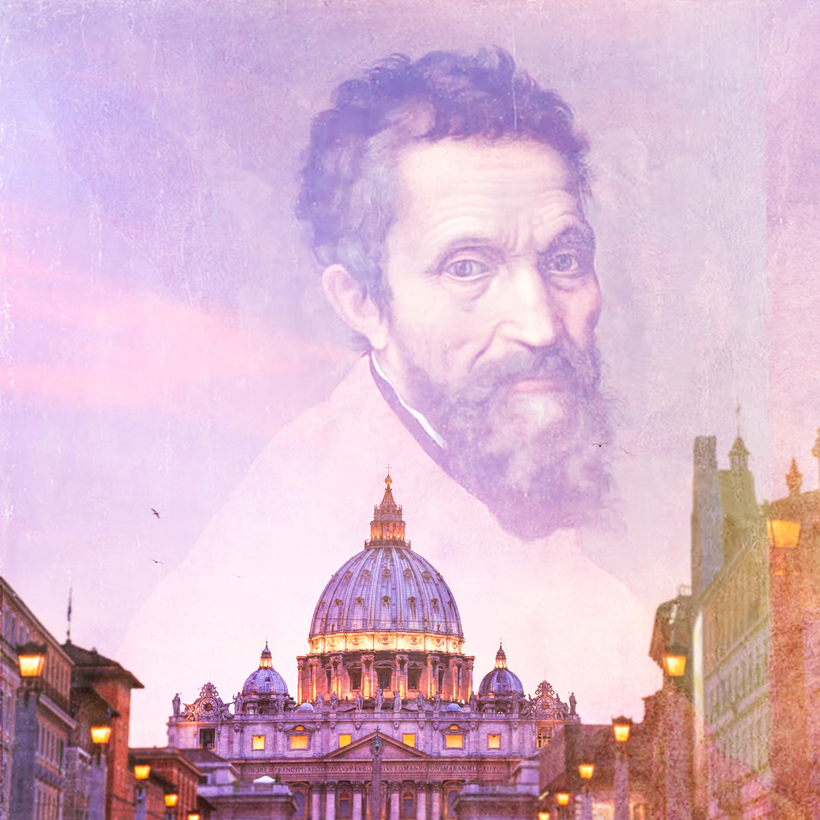Today we think of Michelangelo Buonarroti with reverence, as a man who held complete artistic license over his many masterworks. Yes, for the better part of his 88 years he was a thundering talent who was in high demand and commanded high fees while creating spectacular sculptures, paintings, and architectural designs for the most prestigious clients of the day. While researching my new book, Saving Michelangelo’s Dome, it was surprising to learn of his reluctance to assume the role of chief architect of St. Peter’s Basilica, in Rome, and the subsequent struggles he went through, bitterly and every day, to maintain control of the construction.
Michelangelo had a reputation for being uncompromising, stubborn, and temperamental to the point of obstinance. Yet his clients put up with him because he was the greatest artist they had ever seen. He had started young—with an inborn talent that was obvious by his early teens while he was training to be a sculptor at Lorenzo de’ Medici’s school at the Garden of San Marco, in Florence. That was where his genius quickly emerged and began to flourish.
In his 20s, Michelangelo had already fashioned two astonishing sculptures out of Carrara marble: David and the Pietà. Then he was awarded, by papal commission, to paint the Sistine Chapel’s ceiling, in Rome, where he created one of the world’s most colorful and extraordinary murals. It is staggering to consider that the young man had little experience beforehand with fresco technique, which is among the most difficult mediums to master, as the painted pigments must be mixed and then quickly applied while the plaster is still wet. A decade later, the Medici family lured him back to Florence to design its Laurentian Library, where he divined an interior space that was at once stately, monumental, and pragmatic—features that would define his architectural legacy.
The Basilica Battle
In the autumn of 1546, the artist was 71 years old, feeling his age, and thinking about retiring. At that moment, Pope Paul III was desperate to find a suitable replacement who could design his glorious new church, St. Peter’s Basilica, on Vatican Hill. His chief architect (or capomaestro), Antonio da Sangallo the Younger, had just died. The Pope sought out Michelangelo, whose workshop was just down the street in Rome.
Paul III had long admired Michelangelo’s magnificent body of work, and the two were on cordial terms from their recent collaboration on the Last Judgment, which decorated the altar wall inside the Sistine Chapel. At this stage of Michelangelo’s life, however, he was jaded. He had been working at the Vatican and with its Popes for some 50 years and did not like their politics or their meddling and, most of all, their broken promises on payments. But Paul III showered him with charm and gradually coaxed Michelangelo into assuming the role as capomaestro, which the reluctant architect accepted on condition that he maintain absolute authority over the project. Paul III readily agreed, and so began the final, fruitful chapter of the great artist’s heroic career.
In the seven years before taking on the job, his predecessor, Antonio da Sangallo the Younger, had spent a staggering sum of money to build the new church. This had raised suspicions around Rome of rampant corruption, and that the former capomaestro, his family, and his friends—known as la setta Sangallesca (the Sangallo set)—were getting rich off the project. Moreover, Michelangelo had openly expressed disdain for da Sangallo while he was alive and believed him bereft of architectural talent.
Michelangelo Buonarroti had a reputation for being uncompromising, stubborn, and temperamental to the point of obstinance.
There was bound to be trouble. It started on the first day that Michelangelo showed up on the site, in the winter of 1547. He scrapped da Sangallo’s earlier design and wrote about the “infinity of mischief” that came with it. This infuriated la setta Sangallesca, who immediately saw the new capomaestro as a threat to da Sangallo’s memory, their personal authority, and their ability to feather their nests. They hated Michelangelo for it, and the hatred grew into a running feud that lasted for the next 17 years.
One antagonist was Cardinal Marcello Cervini, who often berated Michelangelo with intemperate language and wanted him thrown off the job. The depth of ill will and distrust ran so high that Paul III was often obligated to intercede between the parties and reaffirm Michelangelo’s absolute authority on decisions. It became a daily struggle for the aging capomaestro, about which he bitterly and constantly complained.
The great artist forged ahead for nearly two decades without interruption. But funding for the new church began to stall around 1560, and a weary Michelangelo found himself slowing down with it. He had served five Popes in the role of capomaestro and was faltering from painful physical ailments, embarrassing mental lapses, and errors in judgment that were at times expensive to fix. Clearly, the great artist had had enough when he wrote to “the Most Worshipful Lord Cardinal of Carpi” that “I have endeavored … during the last seventeen years [and] … if I am successful in obtaining permission to relinquish my task I shall consider it as the greatest kindness that could be conferred upon me.”
Ultimately, the great artist overcame these struggles. He persisted and soldiered on as the capomaestro for another four years—until his death, in February 1564, and just two weeks shy of his 89th birthday. By then he had shaped the design of St. Peter’s Basilica (and its titanic, new dome) in a way that would irreversibly seal the success of the project. Michelangelo’s stubborn streak had its merits, after all.
Wayne Kalayjian is a civil and structural engineer

